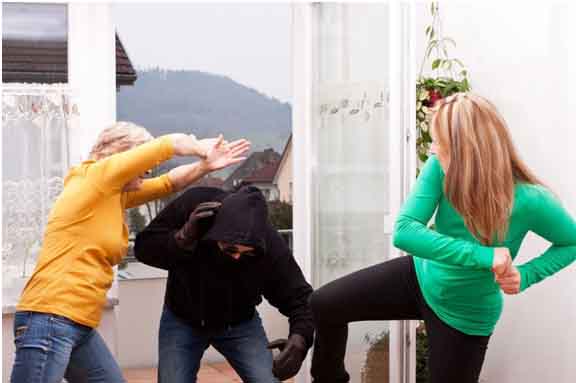Innocent Until Proven Guilty: Four Arguments Of Self Defense
Preserving the personal safety of innocent people is a fundamental human right. The law does not require victims of a violent attack to stand still and do nothing. However, the dynamics of a defensive situation often involves all participating parties being arrested or at least detained initially. Situations involving the use of physical force against another person may result in a variety of different charges, ranging from misdemeanors like simple assault or simple battery to capital crimes like murder. Should criminal charges be filed, the victim should be aware of several possible defenses.
1. Defense of Self
a) An imminent threat is the first argument of self-defense. Generally, a person who reasonably believes that he or she is faced with an imminent threat of bodily harm may use a reasonable amount of force to stop the threat. The person who employs force against another must reasonably believe that the force is necessary to accomplish the threat.The reasonable person’s belief is an objective standard and is based upon what a hypothetical reasonable person would have believed had they been in the actor’s place. However, it is not specifically what the actor believed at the time that he or she employed force.
- Additionally, the threat must be imminent. This means that the aggressor apparently has the resources, opportunity and intent to commit a violent act immediately. A person who points a firearm at another person and threatens him or her is employing deadly force, to which the victim may respond with reasonable force. In this case, reasonable force would be deadly force.
- A person who threatens to retrieve a firearm from another location and return to kill the victim is not employing deadly force because the threat is not immediate from a legal perspective.
b) The honest but unreasonable person is one who honestly,but unreasonably believes that they face an imminent threat and employs force against that threat. Because of this, they may be eligible for a reduced charge. In California, this is called an act of imperfect self-defense or imperfect defense of others. A person who employs deadly force in such a situation and kills the other party will be eligible for a reduction from murder to voluntary manslaughter. Such a conviction will greatly reduce the amount of time spent in prison.
- Victims of such attacks may respond with an appropriate level of strength for the threat faced. This usually involves meeting force with the same amount of force or less then the strength displayed by the aggressor and no more. Unfortunately, whether a particular action qualifies as self-defense is not always clear.
- Deadly force may come from an unarmed assailant if there is a gross disparity in power or if there are multiple assailants.
- Force that was not intended to cause death or great bodily injury may result in a fatal injury nonetheless. Whether the amount of force applied in a particular situation was reasonable will be an issue in most self-defense cases.
c) Cease employing force is part of the law that requires citizens to cease employing force once the threat has ended. Pressing the attack after the threat has ended can turn a legitimate self-defense claim into a serious crime. In 2009, Oklahoma pharmacist Jerome Ersland fired at two armed robbers who entered his shop, one of whom brandished a weapon. Ersland non-fatally shot the one without a weapon and chased the other out the door while abstaining from firing further.
This constituted a lawful use of force since the armed robbers posed an imminent threat of death or great bodily injury. But, Ersland returned to the store, retrieved another weapon, and shot the wounded and now unarmed robber again, inflicting fatal wounds. He was convicted of murder and is presently appealing his life sentence.
d) A duty to retreat is imposed upon defendants by certain jurisdictions. This older common law rule required defendants to take every action that they could have to avoid a situation including fleeing the area.
- Most states currently have different castle laws that eliminate the duty to retreat inside one’s home.
- Some states limit the duty to retreat to situations involving deadly force; defendants must not retreat before employing force that does not arise to the level of deadly force.
e) Stand Your Ground laws, found in some states, eliminate the duty to retreat in any area in which the defendant has the right to be lawful. This rule is increasingly antiquated,and many states have done away with it entirely, but it is still on the books in some jurisdictions. Visiting attorney websites like www.devorelawoffice.com can help provide more details on these various aspects of defense of self.
2. Defense of Others
The defense of others law is almost identical to the law of self-defense. Anyone who reasonably believes that another person is facing an imminent threat of bodily injury may respond with a reasonable amount of force to prevent the threat.
a) The law only requires the reasonable belief that the amount of force applied is necessary to protect the innocent person and that the supposed attacker is not acting in his or her own self-defense.It does not require the “Good Samaritan” to be objectively correct.
b) The duty to retreat typically does not require the defendant to retreat in situations involving the defense of others. So deciding to step in and assist another person is more of a practical concern than a legal one.
3. Mutual Combat
 a) Mutual combat is a phrase with different meanings depending upon the jurisdiction.
a) Mutual combat is a phrase with different meanings depending upon the jurisdiction.
- It refers to a conflict that began with the express or implied consent of all parties.
- Mutual combat is usually a crime in itself, often falling under local and state statutes regarding fighting, affray, or disturbing the peace.
- It will involve committing at least one act of assault or battery. However, the fact that theconflict began with the express or implied consent of both parties can be a part of the defense to a more serious charge.
b) There are two self-defense claims under the defense of mutual combat.
- First, a mutual combatant may withdraw his or her express or implied consent to the combat. If the other combatant continues to press the attack, he or she is committing an assault or battery against the person who withdrew from the conflict. In such case, the party that originally was a mutual combatant will be a victim of an assault or a battery and therefore he or she will be entitled to meet the appropriate level of force with force.
- The second instance in which mutual combat will substantiate a self-defense claim occurs when all parties involved are mutual combatants in a conflict that involves a low level of force, and where one party suddenly escalates to greater levels of force.
- A distinction is usually drawn between force not intended or likely to cause death or great bodily injury and deadly force. In such circumstances, even a party who initiated the conflict may employ deadly force and claim self-defense in some jurisdictions.
- Such claims are problematic for several reasons. Many jurisdictions require the defendant to have not instigated the affair before employing deadly force.
4. Defense of Property

Photo Credit: http://www.flickr.com/photos/hodac/2268933474/Olivier Hodac
a) Reasonable force may be used by victims to prevent property crime including theft or vandalism and recover their own personal property.
- Since the threat is to property and not life or personal safety, the force used must be low. Texas authorizes employing deadly force to prevent the commission of or escape from various crimes, including nighttime burglary.
- This is only acceptable if the property owner reasonably believes that lesser levels of force would not result in the recovery of his or her property, or if alternative recovery methods would expose him or her to risk.
- In nearly every other jurisdiction, employing deadly force to protect property is unlawful.
b) Defense of self or others often overlap in situations involving defense of property. While most jurisdictions prohibit property owners from employing deadly force to protect property exclusively, there are particular circumstances involving the defense of property.
- Confronting a thief or burglar is a dangerous affair. Many criminals will threaten the property owner when confronted, thus turning a theft, larceny or burglary into a robbery. In such circumstances, victims may face threats to their own personal safety and may use higher levels of force to stop the threat that now exists.
- Victims of property crime may also conduct a citizen’s arrest and arrest the perpetrator. Generally, private citizens have the same powers of arrest that police officers do. The differences are that private citizens do not have qualified immunity from lawsuits. Most private citizens do not have thetraining in subduing suspects, and most lack the equipment available to officers.
- Self-defense trainers usually advise against attempting a citizen’s arrest without law enforcement assistance for these reasons, but citizen’s arrests are lawful. As always, citizens must use no more force than reasonably necessary to effect the arrest.
- Different jurisdictions have different laws on the matter,and anyone intending on performing a citizen’s arrest should consult an attorney before doing so.
- The law pertaining to self-defense and defense of others is relatively simple. Victims may respond to imminent threats and use a reasonable amount of force in order to prevent that threat.
- Persons who were the primary aggressor or who were mutual combatants must clearly communicate their intentions to cease fighting before being authorized to act in self-defense.
- Variances in the law between jurisdictions usually pertain to how clean a defendant’s hands must be and whether he or she has a duty to retreat in a particular location.
Personal protection is rarely simple. Most defensive events are not clearly caught on camera or occur within the boundaries of one’s own home. Criminals lie frequently,and many aggressors will claim that they were victims of an attack. When it is clear that an altercation took place but it is unclear what transpired, officers will usually arrest all parties involved and let the prosecutor sort out the situation.
Self-defense is an affirmative defense that attempts to justify actions that would constitute a crime under other conditions, and must be raised by the defendant. Exculpatory statements are inadmissible as hearsay and roadside proclamations of innocence are expected to result in statements that may be used against the victim. Self-defense cases can become very complicated. It is essential to always seek an attorney’s advice if facing a legal case of self-defense.
About the Author
Nicole Bailey-Covin is a former NBC Affiliate news reporter of 12 years. Over the years,she has covered many criminal trials and taken part in attorney focus groups. She went to www.devorelawoffice.com for research and encourages other to seek guidance if they have been charged with a crime after defending themselves from physical harm or loss of property.
Additional Legal Sources:
http://www.lectlaw.com/def/d030.htm
Criminal Law 505. Justifiable Homicide: Self-Defense or Defense of Another :: Justia
Criminal Law 3471. Right to Self-Defense: Mutual Combat or Initial Aggressor :: Justia
texas law on re reasonable force in self defense – Yahoo News Search Results
Criminal Law 571. Voluntary Manslaughter: Imperfect Self-Defense – Lesser Included Offense :: Justia







 Blog Home
Blog Home 










